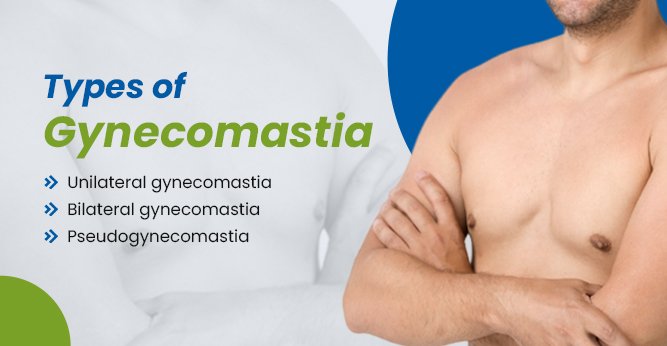
Gynecomastia is a condition characterized by the enlargement of breast tissue in people assigned to male at birth (AMAB). While breasts do not develop in AMAB individuals the same way they do in those assigned females at birth (AFAB), everyone is born with some amount of glandular breast tissue. This condition typically arises when there is a hormonal imbalance in the body.
In this blog post, we will share comprehensive insights into gynecomastia, including its causes, symptoms, diagnosis, and treatment options. Read on for more!
The Basics of Gynecomastia
Gynecomastia occurs when the balance of hormones in the body shifts, leading to an increase in estrogen or a decrease in testosterone. Testosterone is the hormone responsible for male body changes during puberty, while estrogen drives sexual and reproductive growth in females. In males, a higher estrogen level compared to testosterone can cause breast tissue to swell.
Gynecomastia can affect males of all ages and may occur at different times in life. It is estimated that around 65% of boys and men worldwide are affected by this condition.
Gynecomastia vs. Fat
Having enlarged breasts does not always mean an individual needs to lose weight. The breast comprises glandular and connective tissue, with fat deposits filling the spaces in between. Everyone has a unique ratio of these tissues. Gynecomastia specifically affects glandular breast tissue and is not directly related to body fat levels.
While gynecomastia is usually not a serious health issue, it can cause anxiety or embarrassment due to its impact on appearance.
Types of Gynecomastia

Doctors use various terms to describe gynecomastia based on its presentation:
- Unilateral Gynecomastia: Only one breast is enlarged.
- Bilateral Gynecomastia: Both breasts are enlarged.
- Pseudogynecomastia: It occurs due to excess fat deposits, often seen in individuals with extra weight, but not the same as gynecomastia.
Causes of Gynecomastia
Natural Changes in Hormones
Infancy: Over half of male infants have swollen breasts due to the influence of maternal estrogen.
Puberty: Hormonal fluctuations during puberty can lead to temporary gynecomastia, which typically resolves as hormone levels stabilize. Approximately 60-75% of adolescent males experience this condition.
Older Age: After the age of 50, gynecomastia becomes more common due to a natural decline in testosterone levels.
Andropause
Andropause, often referred to as male menopause, is a phase in a male’s life where the production of testosterone declines over several years. This hormonal change can result in gynecomastia, hair loss, and insomnia.
Breastfeeding
Infants who are breastfed or chest-fed may develop gynecomastia due to the presence of estrogen in breast milk.
Drugs and Alcohol
Certain drugs and substances can increase estrogen levels and contribute to gynecomastia. These include:
- Steroids
- Amphetamines
- Alcohol
- Heroin
- Marijuana
- Methadone
Exposure to endocrine disruptors, commonly found in plastics, has also been linked to gynecomastia.
Other Medical Conditions
Less common causes of gynecomastia include:
- Testicular tumors
- Liver failure (cirrhosis)
- Hyperthyroidism
- Chronic renal failure
- Adrenal tumors
- Klinefelter syndrome (an inherited condition)
- Male hypogonadism (low testosterone)
- Pituitary gland tumors (pituitary adenomas), especially prolactinomas.
Symptoms of Gynecomastia
Gynecomastia typically manifests as a button-sized growth under the nipple, which looks like a breast lump. This lump may be tender to touch and can develop in one or both breasts.
Symptoms of gynecomastia include:
- Swollen breasts
- Breast discharge
- Breast tenderness
If you experience these symptoms, consult a doctor to determine the underlying cause. Male breast cancer, although rare, can also cause similar symptoms, making a medical evaluation crucial.
Diagnosis of Gynecomastia
To diagnose gynecomastia, a doctor will review your medical history and conduct a physical examination of your chest and genitals. The presence of breast tissue greater than 0.5 centimeters in diameter is a key indicator. If the cause is unclear, additional tests such as blood tests, mammograms, or ultrasounds may be necessary. In some cases, MRI scans, CT scans, X-rays, or biopsies might be performed.
Treatment of Gynecomastia
Treatment for gynecomastia depends on the underlying cause and the severity of the condition. Common options include medication and surgery.
Surgery
Surgery can be used to remove excess breast fat and glandular tissue. Common surgical procedures include:
Liposuction
It is a common surgical procedure used to address gynecomastia. This technique involves the removal of excess fat deposits from the breast area through a thin, hollow tube called a cannula, which is inserted through small incisions in the skin. The cannula is moved back and forth to break up the fat, which is then suctioned out of the body.
Liposuction is typically performed under local anesthesia with sedation or general anesthesia to ensure that the patient remains comfortable throughout the procedure.
Gynecomastia surgery recovery time: One of the advantages of liposuction for treating gynecomastia is its minimally invasive nature, which usually results in less scarring and a shorter recovery period compared to more extensive surgical options. Most patients can return to their normal activities within a few days.
Excision
Removal of breast gland tissue, also known as a mastectomy, may be performed with or without liposuction. These surgeries are usually outpatient procedures, allowing patients to return home the same day.
Gynecomastia Surgery Recovery Time
Recovery time after gynecomastia surgery varies from person to person, but generally, most patients completely recover within four to six weeks.
In the first few days post-surgery, it’s common to experience some discomfort, swelling, and bruising, which can be managed with prescribed medications and by following your surgeon’s post-operative care instructions. Avoid strenuous activities and heavy lifting for at least a few weeks to ensure proper healing.
Always follow up with your surgeon to monitor your progress and address any concerns during your recovery journey.
Gynecomastia Surgery Side Effects
Here are some potential side effects of gynecomastia surgery:
- Pain and Discomfort: Common in the initial recovery phase.
- Swelling and Bruising: Usually subsides within a few weeks.
- Scarring: There may be some scarring, but it typically fades over time.
- Numbness or Changes in Sensation: Temporary numbness or altered sensation in the chest area can occur.
- Infection: Rare but possible, typically prevented with proper post-operative care.
- Hematoma: Accumulation of blood under the skin, which may require drainage.
- Asymmetry: Slight differences in the appearance of the chest may occur.
- Seroma: Fluid accumulation that may need to be drained by your surgeon.
These gynecomastia side effects are not experienced by everyone and are generally short-term and easily manageable with doctor’s advice.
Medications
Doctors may prescribe medications that affect hormone levels, such as tamoxifen (Soltamox) and raloxifene (Evista), to manage gynecomastia.
Living with Gynecomastia
Living with gynecomastia can be challenging, especially for adolescents and young adults who may feel self-conscious about their appearance. Support from family, friends, and healthcare professionals can make a significant difference. Counseling and support groups provide a platform to share experiences and coping strategies.
Preventing Gynecomastia
While not all cases of gynecomastia can be prevented, some lifestyle changes can reduce the risk. Avoiding the use of steroids, limiting alcohol consumption, and staying away from recreational drugs can help maintain a healthy hormonal balance. Regular exercise and a balanced diet can also support overall health and potentially reduce the risk of developing gynecomastia.
Find the Best Clinic for Gynecomastia Surgery in Surat
If you are searching for the best cosmetic clinic for gynecomastia surgery in Surat, consider factors like the surgeon’s experience, the clinic’s reputation, and the quality of care provided. Celebre Aesthetics in Surat, led by Dr. Sakhiya, stands out as a top choice for cosmetic surgery. With over 10 years of experience, Dr. Sakhiya has a proven track record in various procedures, including gynecomastia surgery.
At Celebre Aesthetics, we provide personalized care to each patient with gynecomastia. Our patients benefit from round-the-clock doctor availability and 24/7 care. The clinic boasts cutting-edge infrastructure and state-of-the-art surgical procedure rooms, equipped with world-class machines for safe and effective treatments.
Contact us now to schedule an appointment with our top plastic surgeons.



